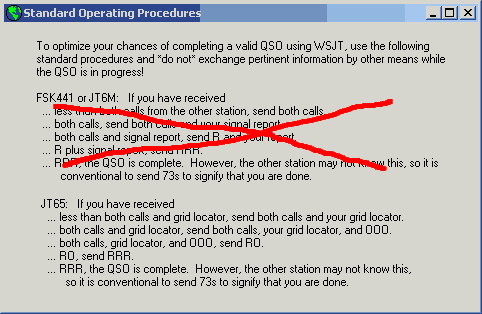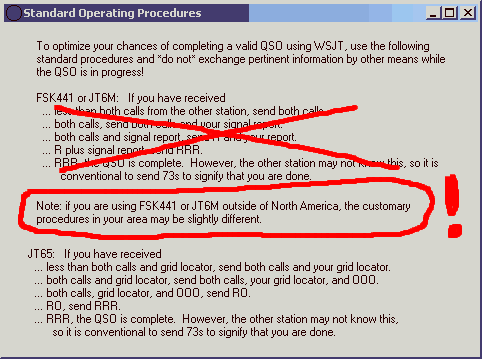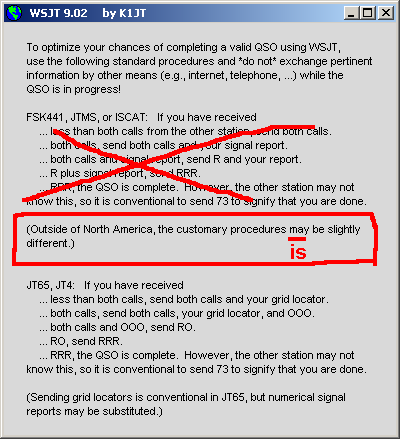
2018-11-26
| MS Procedure | QSO Examples | MS Report | WSJT |
The Meteor Scatter tips and tricks described here are based upon more than 35 years of active MS operation. A lot of it has to do with IARU recommended Meteor Scatter Procedure that may seem hard to understand at first glance. Thus the following topics are described:
One remark though on the issue of the IARU recommended Meteor Scatter Procedure is that many individual web pages and programs try to explain or interpret the IARU recommended Meteor Scatter Procedure and sometimes these are not updated. In order to avoid all this do only accept the original nothing less than that.
The IARU recommended Meteor Scatter Procedure (MSP) can be found at the IARU webspace (warning: PDF file!) here.
IO and JO stations use second period 98% of the time when working outside the "IO-JO Box." Stations working another station "inside-inside" or "outside-outside" the "IO-JO Box" agree on this on a case by case basis and choose a frequency that is far away from the activity centre. This is in line with the principles recommended by the IARU, MSP 4.4.4, and more than 35 years of operation.
| - | Never transmit in opposite periods according to your own geography, MSP 4.4.4. | ||
| o | If you really want to operate in the opposite period choose a frequency far away from everybody else and avoid operation if the band is crowded. | ||
| o | If you are on expedition never change your TX period as it will confuse all the calling stations. | ||
| - | Never break into an existing sked no matter what and even if the sked partners do not hear each other. | ||
| - | Never swap parts of the message, e.g. do not send HisCall Report YourCall Report, it makes it impossible for others to identify who is transmitting. Furthermore, may it lead to a less secure interpretation by the other station. | ||
| - | If a confirmation report is received at an early stage in the contact, the other operator has all the information he needs. The following strings can be used to ask for missing information: | ||
| o | BBB | Both call signs missing | |
| o | MMM | My call sign missing | |
| o | YYY | Your call sign missing | |
| o | SSS | Duration and signal strength missing | |
| o | OOO | All information complete | |
| o | UUU | Faulty keying or unreadable | |
| The other operator shall respond by sending only the required information. This approach must be used with great caution to prevent confusion. But if you receive one of the above strings it does not mean RRR! | |||
Bad behaviours or actions that will invalidate an MS QSO attempt, according to the MSP, are:
You may also take a more dubious approach to the MS procedure here.
The IARU recommended MS random, i.e. CQ, frequencies are:
Due to the fact that you are likely to find a lot of non meteor scatter traffic on the bands, e.g. many SSB stations can be found up to 144,370 MHz, I recommend that you always pick a frequency according to the below list:
* Note: Each country may have very different 70 MHz band frequency allocation(s) thus only the available segments can be used and as a consequence meteor scatter traffic may take place almost everywhere.
Motto: "If you do not know why the IARU Region 1 VHF Committee Meteor Scatter procedure is the way it is do not change anything. When you know why it is the way it is, you also know not to change anything."
Below are a number of meteor scatter QSO examples based upon the IARU Region 1 VHF Committee recommended Meteor Scatter Procedure.
Keep in mind that it is the same information that has to be exchanged in a sked and in a random QSO.
If a QSO "gets out of sync" the following strings can be used to ask for missing information:| - | BBB | Both call signs missing |
| - | MMM | My call sign missing |
| - | YYY | Your call sign missing |
| - | SSS | Duration and signal strength missing |
| - | OOO | All information complete |
| - | UUU | Faulty keying or unreadable |
In the IARU recommended Meteor Scatter Procedure the signal report is sent twice in stead of just ones. Why is that?
Exchanging information over meteor scatter is all about probability and patience. Let us look at a couple of examples given the QW1XYZ and OZ2M call signs are used. Keep in mind the procedure stipulates that both call signs have to be received in full. Furthermore a shorter message will be received more often increasing overall probability.
Table 1: Comparison of character probability versus the number of times the signal report is sent.
| Report twice | Report three times | Report ones | |||||
| Character | Probability | Character | Probability | Character | Probability | ||
| Q | 5,6% | Q | 4,8% | Q | 6,7% | ||
| W | 5,6% | W | 4,8% | W | 6,7% | ||
| 1 | 5,6% | 1 | 4,8% | 1 | 6,7% | ||
| X | 5,6% | X | 4,8% | X | 6,7% | ||
| Y | 5,6% | Y | 4,8% | Y | 6,7% | ||
| Z | 5,6% | Z | 4,8% | Z | 6,7% | ||
| space | space | space | |||||
| O | 5,6% | O | 4,8% | O | 6,7% | ||
| Z | 5,6% | Z | 4,8% | Z | 6,7% | ||
| 2 | 5,6% | 2 | 4,8% | 2 | 6,7% | ||
| M | 5,6% | M | 4,8% | M | 6,7% | ||
| space | space | space | |||||
| 2 | 11,1% | 2 | 14,3% | 2 | 6,7% | ||
| 6 | 11,1% | 6 | 14,3% | 6 | 6,7% | ||
| space | space | space | |||||
| 2 | (11,1%) | 2 | (14,3%) | ||||
| 6 | (11,1%) | 6 | (14,3%) | ||||
| space | space | ||||||
| 2 | (14,3%) | ||||||
| 6 | (14,3%) | ||||||
| space | |||||||
| 18 characters | 21 characters | 15 characters | |||||
When sending the report ones the probability for each characters is the same and given the fact that all characters have to be received it makes a lot of sense. Unless ...
...
We cheat!
Some possible reasons:
WSJT is a very useful piece of software acknowledged by many radio amateurs through out the world. Unfortunately there are some slips in the way WSJT deals with the IARU recommended Meteor Scatter Procedure.
The signal reports suggested by WSJT in the "Rpt" column does not comply with the IARU recommended Meteor Scatter Procedure. Thus you should not use one of these when entering the "right report" into the edit box. The correct reports are shown below:
| First number | Second number | |||||
| (burst duration) | (signal strength) | |||||
| 2 | : | up to 0,5 s | 6 | : | below S2 or below 5 dB | |
| 3 | : | 0,5 - 1 s | 7 | : | from S2 to S3 or from 5 dB to 10 dB | |
| 4 | : | 1 - 5 s | 8 | : | from S4 to S5 or from 10 dB to 15 dB | |
| 5 | : | longer than 5 s | 9 | : | above S5 or above 15 dB | |
Please note that "1" is not used in the report.
Another mismatch is the WSJT Standard Operating Procedures, evoked by pressing F5.



In brief words and in same style as WSJT the IARU recommended Meteor Scatter Procedure can be written like:
Start by sending both calls (Msg 1)
If you have received:
... his call or own call or parts of one them send calls and report (Msg 2)
... both calls complete and report send calls and R-report (Msg 3)
... both calls and R-report send RRRR RRRR own call (Msg 4)
... RRR, the QSO is complete! But you may respond with 73 own call (Msg 5)
You can also download the complete IARU recommended Meteor Scatter Procedure here.
A trick that you may apply when working on the random frequency is to change Message 4 into "RRRR own call" or "RRRR own suffix" if your call is long, as this will make it easier for the receiving station to identify who is sending the RRRs. But do not waste reflections and probability on transmitting the receiving station's call when sending RRRs.
In IARU Region 1 the Single Tone Messages are not used. So a decode and subsequent display of such a message is irrelevant.
See also Meteor Scatter above for a discussion of compliance between WSJT and the IARU recommended Meteor Scatter Procedure.
Bo, OZ2M, www.rudius.net/oz2m